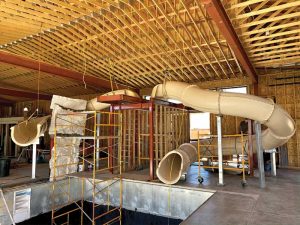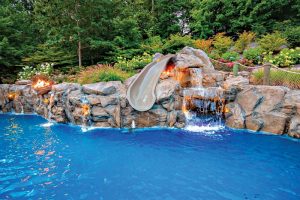
These GFRC panels are readily available, easy to ship, and look real because they are cast from real rock—creating the same shape, character, and texture—making it hard to tell the difference between cast concrete and real stone.
Water features
Large water features, including grottos and waterfalls, are almost expected at many high-end commercial pools. Depending on the aquatic facility, these types of water features can be quite large; in fact, one recent installation at a high-end waterpark resort used an artificial rock component system to create a large, one-of-a-kind custom waterfall and grotto combination. This feature used approximately 185 m2 (2000 sf) of GFRC panels. This particular grotto-style water feature incorporated a one-piece “stream section,” which was engineered to provide a precise pathway for the water coming off of the feature by using a simple, pre-designed formation of smaller rocks—imitating the natural rock pathway found in a stream. One of the greatest benefits of these component kit systems is the fact they have been designed to ensure proper water flow back into the pool and not on decks or the water feature itself. It can be challenging for builders using natural rock to get the water to flow in the desired direction. When water gathers on decks, this standing water can lead to slippery algae growth, or even fractures in mortar and cement, especially in freeze-thaw regions. This is where artificial rock can really help builders ensure a functional final product that enhances the aquatic environment.
Smaller water features made of cast-concrete rock are also highly effective at creating soothing sounds with cascading water to enhance the appeal of commercial aquatic facilities. Aquatic facilities with lazy rivers have found lining the river with artificial rock and cascading water gives it extra esthetic appeal.
Light them up
Beyond being attractive to the eye, cast-concrete artificial rock features are also easy to illuminate for nighttime pizzazz. Since the rocks are made of concrete, they can be custom equipped with lights, as installers can drill into them without difficulty. It is also easy to cut channels into their surfaces to embed long lighting strips which illuminate the rockwork. The objective is to hide the light source within the water feature around the slide, creating a fascinating glow as the lights are dimmed or as the sun sets. Further, lighting within artificial rock also adds dazzle and warmth. Even if the aquatic facility is not open at night, nighttime lighting will attract those passing by, making them the perfect marketing tool.

In addition to esthetics and marketing, lighting is also important for safety—especially on a pool slide where the staircase leading to the top may need extra illumination. The electricity for lights is easy to run behind concrete rocks and can be hidden behind panels, which are then also easy to remove to create access points for maintenance needs.
Aquatic facilities looking to update their pools and add “waterpark wow” should consider the versatile and affordable use of artificial rock to “dress up” slides, create climbing walls, and add water features with lighting options that will become the talk of the town.
 Author
Author
Zayvian Camacho is part of the design and fabrication team at Rico Rock, developing new climbing walls and water features and working on commercial aquatic and non-aquatic construction projects. Camacho has a degree in landscape design and has overseen construction for dozens of unique cast-concrete artificial rock projects in backyards, hotel resorts, bowling alleys, zoos, and more. He finds his rock construction work meshes perfectly with his passion for rock climbing. He can be reached at zayvian@ricorock.com.






